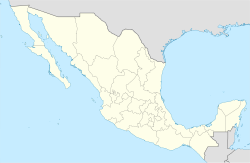Carácuaro
| Carácuaro | |
|---|---|
| Municipality | |
| Coordinates: 19°01′00″N 101°07′34″W / 19.01667°N 101.12611°WCoordinates: 19°01′00″N 101°07′34″W / 19.01667°N 101.12611°W | |
| Country |
|
| State |
|
| Established | 1 February 1856 |
| Seat | Carácuaro de Morelos |
| Government | |
| • President | Walter Gómez Gutiérrez |
| Area | |
| • Total | 920.855 km2 (355.544 sq mi) |
| Elevation (of seat) | 538 m (1,765 ft) |
| Population (2010 Census) | |
| • Total | 9,212 |
| • Estimate (2015 Intercensal Survey) | 9,485 |
| • Density | 10/km2 (26/sq mi) |
| • Seat | 3,653 |
| Time zone | Central (UTC-6) |
| • Summer (DST) | Central (UTC-5) |
| Postal codes | 61920–61938 |
| Area code | 459 |
| Website | Official website |
Carácuaro is a municipality in the Mexican state of Michoacán, located 77 kilometres (48 mi) south of the state capital of Morelia.
The municipality of Carácuaro is located in the Tierra Caliente region of Michoacán at an altitude between 400 and 1,600 metres (1,300–5,200 ft). It borders the municipalities of Nocupétaro to the west, Madero to the north, Tiquicheo to the east, Huetamo to the south and Turicato to the southwest. The municipality covers an area of 920.855 square kilometres (355.544 sq mi) and comprises 1.6% of the state's area.
Carácuaro is located in the southern foothills of the Trans-Mexican Volcanic Belt, in the Balsas River basin. Tropical forests of parota and tepeguaje cover 66% of the municipality.
Carácuaro's climate is tropical with rain in the summer. Average temperatures in the municipality range between 22 and 28 °C (72–82 °F), and average annual precipitation ranges between 700 and 1,000 millimetres (28–39 in).
Prior to the arrival of the Spanish, Carácuaro was a small Chichimeca village. The place name derives from the Chichimeca word carakua, "place of the slope" or "place on the slope." The Spanish founded a mission in Carácuaro in 1581. Originally a meat production centre for the towns of the Bajío, it eventually became a centre of tropical fruit and sugarcane cultivation. José María Morelos served as the parish priest from 1799 until 1810, when he joined the rebels in the Mexican War of Independence. Carácuaro's significance declined after the war, despite it becoming a municipality on 1 February 1856. After the Mexican Revolution, emigration to central Mexico and the United States became common.
...
Wikipedia

